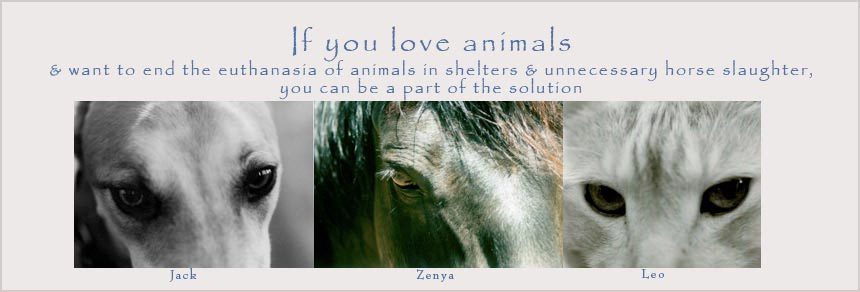Animal Communication
Client-Centered, Empathy-Based Approach to Animal Communication, Grief Support & Healing
copyright 2006 Teresa Wagner
all rights reserved

The role of healing arts practitioners--whatever their specific training, expertise or position--involves a sacred trust in which the healer holds the space for client to find their own way. A healer's role is to shed light on another's path, not to push them onto the path we think they should take, or to even gently tell them which path to take. A healer's job is to shed light, lovingly, empathically and skillfully, to help others find their own way.
Whatever skills, gifts, abilities or healing modalities we have to offer, they must be given only with the permission of the client, and must fit the needs and goals of the client. In a client-centered, empathy based approach to animal communication, grief support and any healing, we do our best work when we meet clients where they are, not where we are, or where we want them to be or think they should be.
Our spiritual maturity and poise as healers, our ability to create a healing presence and to help our clients truly grow and heal is heightened when we refrain from imposing our judgments, values or favorite healing modalities and solutions, and rather, trust in the wisdom of the other being's soul and ability to heal as we offer our knowledge, skills and abilities.
What is it?
In the 1950's the late Dr. Carl Rogers created a revolution in the field of psychology in developing the client-centered approach to counseling and psychotherapy. It contrasted sharply with predominant counseling theories of the time. One was the Freudian psychoanalytic view asserting that people are basically neurotic with little chance for change (unless they saw a psychoanalyst multiple times a week for many years), and that the therapist's role is to project their expert analysis onto the client to help them adjust to life as it is. Another was the Skinnarian view asserting that emotions are irrelevant to growth, that we are products of environment only, and that behavior modification is the only thing that induces significant change.
What Rogers believed, researched, practiced and taught for several decades is that the potential for humans to grow is limitless and that the answers for what is needed for healing are inside of every individual. He also asserted that the relationship between the helper and client can in itself facilitate significant growth and healing for clients when it includes certain qualities on the part of the helper, qualities that allow clients to feel safe, completely be themselves and open to their own inner wisdom. The qualities he spoke about were later found through repeated research studies (Carkhuff and Berensen) to be core facilitative characteristics which impact growth and change for clients more than other therapeutic approaches or techniques:
-
Acceptance of clients exactly where and how they are, without judgment
-
Empathy: active attempts to understand the clients' world from their frame of reference
-
Authenticity: remaining humble and genuine as a fellow being with clients, without creating any hierarchy or barriers based on roles, titles, position, degrees, expertise or cultural and gender differences, etc.
Why I use it
As a young undergraduate and graduate student of counseling in the 1970's I felt like I had "come home" when I was introduced to client centered counseling. I resonated deeply with the belief that effective helping is not about projecting our beliefs onto others about where they've gone wrong and what they should do about it. But rather that as counselors we are there to help them discover, uncover and understand for themselves what is not in balance, what may be the deepest core issues underneath what hurts or is not working, and to support them in finding their way through the healing process. As Rogers has said, the client centered, empathy-based approach seems to act like a fertilizer for growth when used with clients. It is tremendously empowering. It allows others to open to significant self-acceptance, learning and deepened self-awareness, without being pushed, pulled or imposed upon.
Since 1976, the energy of the client-centered approach has driven and guided my work through several careers: counseling delinquent adolescents and managing a group home; teaching counseling skills for a national training institute in the juvenile justice system, coaching managers and executives as an organization development manager for RCA, serving as a hospice grief counselor, a pet loss counselor and support group facilitator, and as an animal communication consultant. The context of my roles changed, but my passion for using a client-centered approach in each has never wavered. Why? Because I've seen it work--no matter what the context and no matter who the clients have been. And, sadly, I've witnessed other helping approaches stop clients' healing journeys in their tracks. I have seen this approach work quiet little miracles of helping animals and humans open to love—love from others and for oneself, soften rigidity, melt down barriers, release held in pain, and feel release from a sense of isolation, deepened intimacy in relationships, easier reconciliation of differences and collaboration, and problem solving. The client-centered, empathy-based approach helps us effectively communicate the deep compassion and love we as healers so very much want to convey to our clients, and want them to feel for themselves. And, when we have specific healing modalities to share, doing so in a client-centered, empathy-based manner opens the client to receiving and using what we offer far more effectively than when we simply assume we know what they need and impose our tools.
A client-centered, empathy-based approach is one in which practitioners:
-
Are empathic—seeking always to understand the inner experiences of clients from the clients frame of reference—without needing to fit or force the clients' experiences into the practitioner's worldview.
-
Approach their work with humility, with no need to boast to their clients, peers or the public about their abilities, titles, successes or status in their field to feel confident, competent or worthy.
-
Clarify the concerns, feelings, needs and goals of the client at the beginning of a consultation.
-
Clarify for the client what to expect in a session and describes any specific healing modalities available for the session, so the client can feel comfortably informed from the beginning, as well as have the opportunity to say yay or nay to any healing processes, modalities or resources the practitioner has described as available.
-
Focus on the goals and needs of the client throughout the consultation, helping the client re-clarify whenever necessary, offering healing tools, suggestions, of other information only when relevant to the goals and needs of the client.
-
When offering animal communication consultations, facilitate an interactive discussion between the animal and human clients, helping them more clearly hear and deeply understand each other's issues, sharing all the subtleties and nuances that are part of telepathic messages from the animal for the human, allowing the human client opportunity to respond to these—rather than providing mere declarations of information.
-
Treat each client and consultation as unique, setting aside all assumptions (including those about species or breed when working with animals) or past experiences with the issue at hand. Keeps these assumptions in one's "backpack of knowledge and experience" to be taken out and used only after careful consideration about whether there is a relevant match to the client's energy and situation.
-
Apply healing modalities with great discernment of relevance to the clients and situation involved. Client-centered, empathy-based practitioners do not apply healing modalities indiscriminately, however comfortable and skilled they may be with a particular method, or however successful the modalities may have been with other clients. They do not assume that what worked for some will work for all. Whatever skills, gifts, abilities, or healing modalities we have to offer, they must be given only with the permission of the client, and must fit the needs and goals of the client.
-
Always, always make suggestions versus imposing any solutions, ideas, beliefs, ideas, philosophies, or referrals. The client-centered practitioner respects the wisdom of the client and the right of clients to make decisions of their own.
-
Listen for and gently probe for the unique story, feelings, and underlying causes of issues from each individual animal and human in each interaction or consultation with the client. A client centered practitioner never assumes the root cause or solution of one client's issue will be the root cause or solution for another client's situation.
-
Do not foster dependency; rather look continually for ways to empower clients to become more informed, educated, linked to resources, and able to help themselves.
-
Know that all effective and ethical healing is grounded in compassion and love, and, that skills to effectively communicate these qualities must be developed and strategically applied to allow that compassion and love to effectively facilitate healing for another being.
-
Meet and accept clients where they are—emotionally, behaviorally, spiritually, and with their values and belifs—not where we want them to be, think they should be, or where we are.
-
Understand that the role of healer is a sacred trust in which the healer holds the space for another to find their own way. The degree to which we may hold another's hand as they find their way varies with the maturity level and needs of that person or animal. Sometimes in a crisis we may even need to "carry" a client for a temporary time. But this is always done with the intent of helping them get back on their feet to find their own way. A healer's role is to shed light on another's path, not to push them onto the path we think they should take, or to even gently tell them which path to take. Our job is to merely shed light, however lovingly and skillfully, so they can find their own way.
-
Learn to be comfortable in the face of others' pain, and do not attempt to hurry up to somehow lessen the pain of a client so we can feel comfortable, competent, or a have a sense of completion of having fixed the problem. Client-centered, empathy-based practitioners learn to be present with pain and also help their clients learn to be comfortable with their pain, guiding them to discover root causes and long term healing possibilities, rather than offering only quick fixes to alleviate the pain of symptoms.
-
Understand the critical importance of keeping their personal opinions, values and their spiritual beliefs to themselves during consultations, to prevent inappropriately or unduly influencing clients to make decisions based on the practitioner's values and beliefs. Rather, they assist clients in clarifying their own beliefs and come to their own conclusions about what is best for them (and their animals when this is relevant). This is especially important when clients are in crisis and much more vulnerable to being influenced by others such as a healer, therapist, suport group facilitator, animal communicator, veterinary professional, etc. whom they trust and may see as a person of expertise or authority.
How is a client-centered, empathy-based approach different from other approaches?
Whereas the client-centered approach focuses on the beliefs, needs, interests, personality and unique situation of the client, a more practitioner and technique-centered approach emerges from the beliefs, needs, interests, personality and situation of the practitioners:
| Client-Center, Empathy-Based | Practitioner-Centered, Technique-Centered and Projection-Based |
|---|---|
| Focus is on clients and clients' needs | Focus is on practitioner's technique and what the practitioner thinks is best |
| Help clients clarify their feelings, thoughts and their understanding of the issues |
Tell clients their analysis of the clients' issues |
| Meets clients where they are | Meets clients through the lens of their own theories and paradigms, not the clients' |
| Make suggestions | Is directive |
| Help clients explore possible solutions | Tells clients what is best; imposes solutions |
| With empathy, actively attempts to understand clients' worldview |
See clients via their own world view |
| Healthy humility, "guide on the side" |
Need to be seen as important, an authority, an expert, |
| Comfortable with ambiguity, knowing that root causes can take time to identify and address and that healing can take time |
Need to fix things, sometimes quickly; sometimes miss the root causes |
Client-Centered, Empathy-Based Consultant Approach:
In the context of grief support, a client centered, empathy based practitioner listens first, using empathic inquiry to help the person explore their own inner world, and while always communicating compassions, holds back any impulses to immediately “fix” the person’s pain. One of the most powerful things we can do when helping those in pain or crisis is to help them trust their own feelings, intuition, judgments and wisdom. One of the most egregious things we can do is to impose our own beliefs and values on to them. Client-centered, empathy-based grief support is not about being a dispenser of wisdom or techniques. . . but rather supporting others to find access to their own wisdom even as we may offer healing techniques. Our job is to lovingly and non judgmentally help grievers explore and clarify their feelings and possible solutions to dilemmas, not to tell them the best thing to believe or do. It is always more empowering for a client to find their own way with non imposing, non judgmental suggestions than it is to be told “how it is” or “what to do.”
Whatever our specific role as grief supporters it helps to ask ourselves:
• What is more important to me--to proselytize my known techniques or to help someone heal?
• Is my goal to preach (however kindly and lovingly) to those in grief to get them to believe
and do what I do? Or is my goal to honor them exactly where they are, and help facilitate their healing?
In grief support and in any healing work, the welfare and the healing of the client is the abiding concern of the client-centered, empathy-based practitioner--not their favorite healing tool or desire to influence clients to believe as they believe.
In animal communication, a client centered, empathy-based approach involves having an actual conversation with an individual animal and their person, with telepathic translation of facts, feelings, energies, and images, while providing emotional empathy, acceptance and understanding to both animal and human.
It is not only an "intuitive reading" of another's heart or situation, it is meeting the other being exactly where their heart and soul is at that moment. "Reading" someone's energy is like taking a picture and then describing it. The client centered practitioner provides this gently and lovingly. When we empathically meet another being where they are, not merely reading them so we can tell them what we see, but when we honor them by caring where they are, caring about what hurts or is a dilemma, then the "reading" we offer, the telepathic information we translate for them, has the potential to facilitate real healing.
Practitioner-Centered, Technique or Projection-Based Approaches:
- Assume that the particular values, paradigms, theories, techniques that they prefer are the right fit for perhaps every client or situation. This is particularly sensitive when a client has lost their animal loved one and may be emotoinally vulnerable.
Real Life Example: An animal communicator, in an effort to be supportive, sends flyers to clients and colleagues with information which blatantly proselytizes fundamentalist Christianity, including statements that belief in reincarnation is the work of Satan. Another animal communicator, in an effort to be supportive, sends the Rainbow Bridge poem to all clients who lose their animals. As common as Christian beliefs may be, a client-centered practitioner is acutely aware that all clients do not share the same spiritual beliefs. As comforting as the Rainbow Bridge story may be to many people, the client-centered practitioner keeps in mind that the beliefs it presupposes (i.e. when all animals die they do not immediately go to heaven or continue their own unique soul journey or development, but stay in a beautiful place called the Rainbow Bridge and wait for their human to meet them when they die) may not be the beliefs of every client.
The client-centered, empathy-based practitioner also knows that stating or sending sentiments of sympathy contrary to one's belief system can be offensive to the receiver and create more stress. Client-centered, empathy-based practitioners do not impose their beliefs on clients, but rather, helps them clarify how they may find comfort in their own beliefs. They are sure to write or state sympathy comments that are aligned with the particular client's beliefs, or are careful to keep them neutral regarding spiritual beliefs. When I know a client is Christian in orientation, I may send them a copy of the Rainbow Bridge poem. When I know their orientation is metaphysical, I may send them a copy of Penelope Smith's book Animals in Spirit, as it is metaphysical in examples and in philosophy. In any case, or when I am not sure of their beliefs, I often send a copy of my own audio book, Legacies of Love, in which I intentionally kept out reference to specific spiritual beliefs.
Real Life Example: A holistic veterinarian told a large group of people attending her workshop on animal hospice that euthanasia always causes a bad death and creates a negative afterlife experience for animals. She angrily relayed a story about a client who, after several months of hospice care for her dog, made a choice to have her dog euthanized, against this veterinarian's doctrine and advice that euthanasia is always a bad choice. Though her client did not ask her to speak with her dog's spirit, she did. She told us that she spoke with her client's dog after he was euthanized and that the dog told her to tell his human: “You killed me and must ask forgiveness! I will never be at peace because of what you did!” She told us that she called her client to share the information she said she received from the dog and hoped it will help the client learn that what she did was morally wrong. This is a clear and extreme example of cruel, egregious and unethical imposing of one's personal beliefs onto a client. -
Imposing Solutions: In this approach, the practitioner is more comfortable imposing solutions for clients than in helping them explore what they see as the best solutions themselves or with providing them with tools to do it themselves. They may assume it's appropriate, that it may actually be helpful to impose ones' beliefs, values, and solutions onto others, and exude attitudes such as these:
• I'm the expert. Here's my tool and I'm here to fix you with it
• I know what's best for you and or your animals; Here is my advice and analysis.
• If you don't follow what I say there is unlikely to be progress or healing.Real Life Example: An animal communication client was concerned about best thing to do about her new kitten crying at the door to go out. The animal communicator told the client: "Your cat wants to go outside. All cats need to roam freely outside. It is natural and necessary for them. It is cruel to keep them inside. If your ten week old kitten cries to go outside, even at night, you need to let him outside! Cats are nocturnal. It's wrong to keep them inside." The human client, despite his instincts to keep the tiny kitten inside, let him out when he cried late in the evening. He was killed by a coyote within a week.
Real Life Example: An animal communication client was upset about her dog urinating in the house. The dog told the animal communicator that he does not like waiting until his person opens the door for him to go out. The animal communicator, without discussing this with the human client, told the dog that his person would install a doggie door for him. Then she lectured the human about how imperative it is that this dog have a doggie door. The communicator did not seem to care that the client already explained that in her rental home installing a doggie door was not allowed. The client now had a disappointed dog who expected a doggie door she could not provide, along with the original problem of inside urination.
- Archetypes or Breed/Species Stereotypes: This occurs when the practitioner is dependent upon or uses species archetypal informaton or common breed specific behaviorial information to define animals and their problems without talking directly with the individual animal. Examples: assuming that most or all cats urinate out of a box for the same reason, that all whales are the carriers of the earth's wisdom, assuming that captive dolphins chose to be captive, assuming all animals go to a rainbow bridge when they die, etc, rather than entering a conversation with an individual being completely open to what that animal actually says: their unique story, feelings, thoughts, or root causes at the base of a problem. Having information about the culture of particular animals can be extremely helpful in understanding and supporting a client. However, in a client-centered, empathy-based approach this information remains in our "backpack of information and techniques" only to be pulled out when we discern that it may be relevant in a particular situation.
In a client-centered approach, information is always sought from the individual being consulted, rather than making assumptions that what is right for one animal or person will be right for all. When communicating with animals, archetypal information is completely irrelevant and can skew information received in telepathic conversation with individual animals. Referring to archetypal information as animal communication is misleading and unethical. If archetypal sterotypes and breed specific information is not cleared from the mind of a practitioner during any conversation with an individual animal, the information received will be filtered and prejudiced. If we don't clear ourselves before every conversation, every time we talk with a rabbit we will expect to hear messages about fear, messages about joy from every dolphin, messages of sage teaching from every wolf or messages about all the wisdom of the universe from every whale.
Client-centered, empathy-based practitoners clear themselves of their personal values and beliefs when working with clients so that these do not filter or distort how they perceive their clients' feelings, thoughts, experiences, situations, or traumas. - Psychic analysis: An analysis or "reading" of an animal's or human's energy or situation. Done well, psychic analysis provides a clear picture or "x-ray" of a situation, providing the client with clear information on which to make further decisions, etc. When psychic analysis is used as a stand alone method, if often includes information beyond or irrelevant to the goals, needs and concerns of the client. When not done well, psychic analysis is offered without regard for the client's goals, needs or desire to participate in the practitioner's particular healing methods which may be imposed. At its worst, it is projective information seen through the filter of the psychic's values, belief systems or their favorite or most comfortable healing modality. It may be void of meaningful interaction with the client, and may provide more of a declaration of the information gleaned, without any or much attempt to help the client understand, digest or integrate the information in a way that is relevant and useful to the client. From a chakra perspective, this approach is done from the third eye chakra without connection to the throat or heart chakra. Psychic training often focuses on third chakra abilities--see and get the information—without regard for how to safely, lovingly and skillfully help the client receive and make sense of the information.
-
A greater need for attention, status or fame than to genuinely serve others: With the practitioner, technique-centered, projection-based approach, there is often bragging or arrogance involved, a need for ego stroking or to receive "credit for the healing." Sometimes practitioners with this stance are more interested (even unconsciously) in the drama of nontraditional healing work and getting noticed for it as someone special, than in simply quietly going about the work of helping. They tend to not have much humility and may have a need to boast about their abilities and achievements.
Real Life Examples: A web site with huge letters on the home page stating, "I have a gift from God that no one else has, and I will heal your animal." A healing circle facilitator and genuinely gifted healer needed to provide a boastful run down at the beginning of each circle that usually sounded like: "On Tuesday I cured a woman of breast cancer. On Thursday I saved a marriage through my gifts of giving God's love to a couple. On Friday I did psychic surgery and removed tumors from a man's lungs." Exaggerated as it sounds, this is a true story. The facilitator's arrogance began to get in the way of the love and light of the group to such an extent that people stopped coming. -
Feel it's perfectly acceptable to shame, bully or ridicule clients.
Real Life Examples: An Animal Communicator tells a client whose indoor cat accidentally got outside: "Well, here is the location where I see your cat, and you should find him easily. But if you don't it is your own fault if someone else finds him and keeps him. It is terribly irresponsible to not tag and microchip your cat. An animal communicator and healer whose web site boasts in large letters: "I have a rare gift from God that only a very few people have" tells her client: "Your dog has cancer because of your problems with your marriage. Your dog has taken on all your emotional pain. I can cure your dog but you need to leave your husband. If you don't I will not help your dog." The client left her husband, then later felt this was wrong and reconciled with him. The healer refused to do any more healing on dog unless the woman got a divorce. This example is the antithesis of a client-centered, empathic approach.Both examples are true stories. -
Misuse or Overuse of the mirroring theory: A common new age theory about animals is this: "Whatever issue your animal has, you must look at yourself because you have it and your animal is mirroring it back to you." A client-centered, empathy-based practitioner believes that though "morroring" sometimes occurs and when it does can be a powerful means of learning, it is not present in every problem or in every relationship. To assume it does is overly simplistic and could be irrelevant or even harmful to impose on clients. The "mirroring" theory is one that should be considered only when in having a conversation with an animal and the animal tells us this is something they are experiencing, rather than assuming that every animal in the world, in every situation is "mirroring."
To assume that every relationship with an animal is about the animal mirroring our issues is to believe that animals are our slaves who did not come to earth for their own purpose, but only to serve humans, whatever the cost to them. -
Misuse of the emotional sponge theory: Another common new age theory about animals is this one: "The purpose of companion animals is to absorb our emotions to help us through life." The client-centered approach believes that while it may be true that there are animals who may do this, and certainly there are many co-dependent humans who do this, it is a gross stereotype to assume—before even speaking with an animal and feeling the specifics of the animal's energy and story—that all animals have taken on the role of absorbing their human's emotions, energy or issues. This is an example of having a favorite tool and applying it to every situation whether or not it fits with the unique issues of an individual. The belief that the core purpose of animals on earth is to absorb human pain, or that even if they have additional purposes that all companion animals sponge up our emotions, is a terribly condescending and limited view of animals. The client-centered, empathy-based approach is one in which it would never be assumed that the core purpose of every individual in an entire species is the same, or that a life purpose for any individual is pre-determined servitude to another. In the client-centered approach we ask, we inquire, and we listen to learn the feelings, stories, thoughts, experiences and energy of the those we are attempting to help. We don't overlay favorite theories as if they are one size fits all.

From Dale Larsen's book The Helper's Journey, Working with People Facing Grief, Loss and Life-Threatening Illness:
Empathy is consistently identified as the most important element of successful helping relationships. Empathy requires freeing yourself to see, understand, and experience life through another’s being. Being empathic means feeling your way into the consciousness of the other person and seeing the world through his or her eyes.
Empathy is at the heart of our helping work, for without the deep understanding it generates, we can’t know what people need or how to assist them. It involves seeing the problems of the other person from his or her perspective, feeling them with him or her, and then delicately checking out the accuracy of your sensings by describing them to the other person.
Empathy is the genuine desire to know the inner experience of the other.







